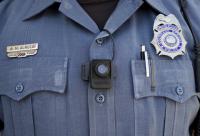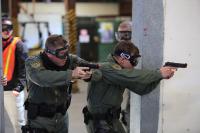-
Terrorist or criminal? New software uses face analysis to find out

Pulling a poker face means betraying no visible emotion, so that opponents cannot tell what you are really thinking. But a Tel Aviv startup’s face-profiling technology recently proved fairly accurate at predicting which four players were most likely to beat out forty-six other contenders in an amateur poker tournament. The company say that its technology, which analyzes faces shown in photos and videos and classifies them according to fifteen parameters predictive of personality traits and types, can help identify terrorists.
-
-
Quantifying the weight of forensic evidence
The weight-of-evidence question comes up anytime a forensic examiner assesses the likelihood that a piece of evidence left at a crime scene originated from a particular source. NIST hosted a technical colloquium on this important question, which virtually every branch of forensic science today faces. The colloquium addressed this specific question: How should forensic examiners quantify the weight of evidence they find in a case? This was the first technical colloquium in the United States to focus specifically on this issue.
-
-
Body-worn cameras associated with increased assaults against police

Preliminary results from eight U.K. and U.S. police forces reveal rates of assault against officers are 15 percent higher when they use body-worn cameras. The latest findings, from one of the largest randomized-controlled trials in criminal justice research, highlight the need for cameras to be kept on and recording at all stages of police-public interaction – not just when an individual officer deems it necessary – if police use-of-force and assaults against police are to be reduced.
-
-
France to employ anti-drone technology to protect Euro 2016 soccer games
France will employ anti-drone technology to interfere with and take control of any flying machines breaching strict no-fly zones over stadiums where the games of the 2016 European Soccer Championship will be played. The technology is part of broad and unprecedented security measures taken to secure Europe’s biggest sports event. French security agencies have been training for some time for the possibility of drones used to disperse chemical agents over crowds.
-
-
Telephone metadata can reveal surprisingly sensitive personal information
Most people might not give telephone metadata – the numbers you dial, the length of your calls – a second thought. Some government officials probably view it as similarly trivial, which is why this information can be obtained without a warrant. Researchers show, however, that telephone metadata – information about calls and text messages, such as time and length – can alone reveal a surprising amount of personal detail. The work could help inform future policies for government surveillance and consumer data privacy.
-
-
Active shooter exercise evaluates tactics, technologies

The New York Police Department (NYPD), the Fire Department of New York (FDNY), and the Department of Homeland Security (DHS) Science and Technology Directorate (S&T) took part in an active shooter exercise early Sunday at a Brooklyn high school to evaluate tactics and technologies for responding to and containing rapidly escalating shooting incidents.
-
-
Harnessing thousands of network cameras for public safety
Researchers have developed a prototype system that could allow law enforcement and public safety agencies to tap into thousands of cameras located in numerous venues including parking garages, college campuses, national parks and highways. In addition to applications in law enforcement, the system can be used to quickly find damage, plan rescues, and other operations during natural disasters.
-
-
FBI does not know how the $1m iPhone hack works
The FBI does not know how the hack which was used to unlock the San Bernardino terrorist’s iPhone 5C works, even though the agency paid about $1 million for the technique. The identity of the hackers who sold the technique to the agency is a closely guarded secret, and the FBI director himself does not know who they are.
-
-
Snowden revelations led to “chilling effect” on pursuit of knowledge: Study
National Security Agency (NSA) whistleblower Edward Snowden’s 2013 mass surveillance revelations caused a drop in website browsing, particularly in internet searches for terms associated with extremism, an example of the most direct evidence yet that the spying operations exposed in the leak had a “chilling effect” on the lawful pursuit of information, an impending report has found.
-
-
Hair analysis is flawed as a forensic technique
Since 1989, seventy-four people who were convicted of serious crimes, in large part due to microscopic hair comparisons, were later exonerated by post-conviction DNA analysis. A new article highlights the statistical failings of microscopic hair analysis in criminal investigations, noting that more than twenty characteristics can be used to describe or identify a single hair, but many are subjective.
-
-
Privacy advocacy groups ask NSA to halt changes to data sharing rules
More than thirty organizations sent a letter to the Director of National Intelligence and the Director of the National Security Agency, urging them to halt reported changes to the rules governing when and how the NSA can share the data it collects through overseas surveillance.
-
-
Four questions Belgians should ask about the Patriot Act

The Paris and Brussels terrorist attacks added a sense of urgency to calls for Belgium to enact its own counterterrorism bill. It is a call the French government has already answered. Increased use of surveillance is a worldwide trend. There is no guarantee, however, that even with the most sophisticated surveillance technology out there today, passing a bill or law to collect private information on citizens will protect us from terrorist threats and violence. Even more vexing: the nature of intelligence gathering means we may never know exactly how many attacks have been prevented by the Patriot Act, the French surveillance law — or a similar law that Belgium may soon pass.
-
-
Flexible security solution makes life difficult for burglars
Ideally, homeowners want to be warned if a burglar sneaks onto their property, and farmers want to know if horses or sheep are no longer in the paddock or field they were left grazing in. Experimental physicists at Saarland University have developed a flexible security solution that can be used in gardens, driveways, business premises, or on grazing land and in woodland.
-
-
FBI cracks terrorists’ iPhone without Apple's help
The Justice Department on Monday asked a court to withdraw the government’s request that the court order Apple to help the FBI gain access to the encrypted iPhone used by the San Bernardino terrorists. The Justice Department filed the request after the FBI had successfully accessed data stored on an encrypted iPhone. The FBI wanted the court to compel Apple to relax the 10-attempt limit, which is part of the encryption system which comes with the device. If there are more than ten attempts to guess the password, the phone locks forever and all the data on it is wiped out. The FBI argued that its computers, using brute-force, would be able to break the phone’s password, but that it would take more than ten attempts.
-
-
FBI may be able to break into San Bernardino terrorist’s phone without Apple’s help

Magistrate Judge Sheri Pym has postponed until 5 April a court hearing about the FBI’s request that the court would order Apple to unlock the phone of one of the San Bernardino terrorists. The FBI asked the judge to postpone the hearing after the agency said it may have found a way to unlock the phone without Apple’s help.
-
- All
- Regional
- Water
- Biometrics
- Borders/Immig
- Business
- Cybersecurity
- Detection
- Disasters
- Government
- Infrastructure
- International
- Public health
- Public Safety
- Communication interoperabillity
- Emergency services
- Emergency medical services
- Fire
- First response
- IEDs
- Law Enforcement
- Law Enforcement Technology
- Military technology
- Nonlethal weapons
- Nuclear weapons
- Personal protection equipment
- Police
- Notification /alert systems
- Situational awareness
- Weapons systems
- Sci-Tech
- Sector Reports
- Surveillance
- Transportation
Advertising & Marketing: advertise@newswirepubs.com
Editorial: editor@newswirepubs.com
General: info@newswirepubs.com
2010-2011 © News Wire Publications, LLC News Wire Publications, LLC
220 Old Country Road | Suite 200 | Mineola | New York | 11501
Permissions and Policies
Editorial: editor@newswirepubs.com
General: info@newswirepubs.com
2010-2011 © News Wire Publications, LLC News Wire Publications, LLC
220 Old Country Road | Suite 200 | Mineola | New York | 11501
Permissions and Policies
